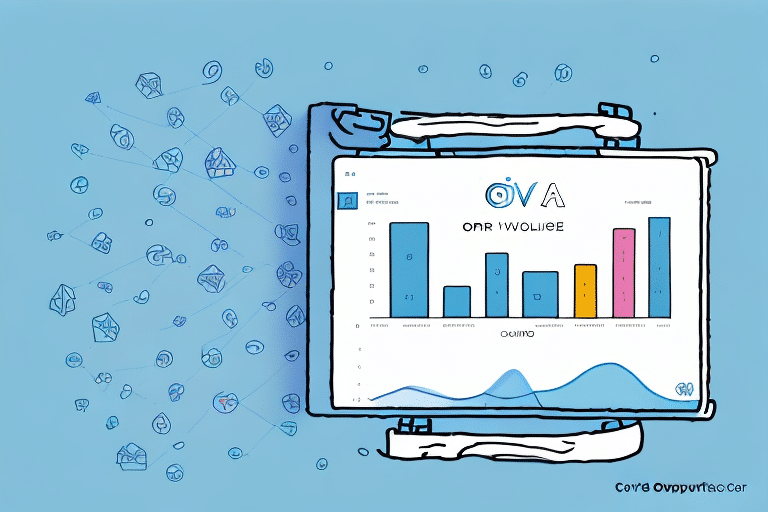Comparing Critical E-Commerce Operations Metrics: Average Order Value (AOV) vs Cart Abandonment Rate
As an e-commerce business owner, measuring and analyzing various metrics is crucial to determine the success of your online store. Two of the most important metrics to monitor are Average Order Value (AOV) and Cart Abandonment Rate. These metrics not only determine the profitability of your e-commerce business but also provide valuable insights into the customer purchase journey. Understanding these metrics, how to calculate them, and the factors affecting them is essential to optimize your online store for success.
The Importance of Measuring E-Commerce Metrics
Tracking key performance indicators (KPIs) is essential for all e-commerce businesses. Measuring metrics allows you to monitor, analyze, and optimize your online store's performance, enabling data-driven decisions and identifying areas of improvement to maximize profitability.
Average Order Value (AOV) and Cart Abandonment Rate are critical metrics to measure to ensure the success of your online store. Additionally, Customer Lifetime Value (CLV) is another important metric, representing the total amount of money a customer is expected to spend on your products or services during their lifetime. Measuring CLV helps identify your most valuable customers, tailor marketing efforts to retain them, and determine the return on investment (ROI) of your marketing campaigns and customer acquisition efforts.
Understanding Average Order Value (AOV) in E-Commerce
Average Order Value (AOV) is the average amount of money customers spend per transaction in your online store. This metric is essential as it enables you to monitor sales and the purchasing behavior of customers. The higher the AOV, the higher the revenue generated per customer transaction, guaranteeing a steady flow of revenue and increased profitability for your e-commerce business.
Strategies to Increase AOV
- Bundle Deals: Offering bundle deals or discounts for customers who purchase multiple items at once encourages them to spend more in one transaction.
- Upselling and Cross-Selling: Suggesting related products or accessories during the checkout process can lead to a higher AOV.
- Free Shipping Thresholds: Setting a minimum order amount for free shipping incentivizes customers to add more items to their carts.
It's important to note that AOV can vary depending on the industry and the type of products being sold. For example, luxury items may have a higher AOV compared to everyday household items. Understanding your specific industry and customer base can help set realistic AOV goals and strategies to achieve them.
How to Calculate Average Order Value (AOV) for Your E-Commerce Store
Calculating AOV is straightforward. Divide the total revenue generated by the number of orders received over a specific period. For example, if your store generated $50,000 in revenue from 1,000 orders in a month, your AOV for the month would be $50.
Knowing your AOV helps make informed decisions about your pricing strategy and marketing efforts. For instance, if your AOV is low, consider offering bundle deals or free shipping to incentivize customers to purchase more items per order. Conversely, if your AOV is high, focus on targeting high-value customers with personalized promotions or upselling tactics.
Source: Shopify on Calculating AOV
Factors Affecting Your Average Order Value (AOV)
Several factors determine the AOV of an e-commerce business:
- Product Pricing: Higher-priced products naturally lead to a higher AOV.
- Product Quality: Premium products allow for higher pricing, contributing to a higher AOV.
- Shipping Costs: Offering free shipping for orders above a certain amount encourages customers to spend more to qualify.
- Checkout Process: A streamlined and user-friendly checkout process can reduce cart abandonment and encourage higher spending.
- Discounts and Promotions: Structured discounts encouraging customers to spend a certain amount can increase AOV without significantly impacting profit margins.
Why Increasing Average Order Value (AOV) is Critical for E-Commerce Success
Increasing AOV is vital for driving long-term profitability and success. A high AOV translates to increased revenue per customer transaction, resulting in a more profitable online store. Furthermore, a high AOV boosts Customer Lifetime Value (CLV), encouraging customers to purchase more frequently, thereby increasing your store's profitability.
Effective methods to increase AOV include:
- Product Bundling: Grouping related products together and offering them at a discounted price incentivizes customers to purchase more items at once.
- Free Shipping Thresholds: Offering free shipping for orders that meet a certain threshold encourages customers to add more items to their carts.
- Limited-Time Offers: Creating urgency with time-limited promotions can push customers to increase their order value.
Source: Business.com on Increasing AOV
Introduction to Cart Abandonment Rate in E-Commerce
Cart abandonment is a prevalent issue in e-commerce, referring to customers adding items to their cart but leaving the site without completing a purchase. Cart Abandonment Rate is the percentage of customers who abandon their carts compared to those who complete a purchase. A high Cart Abandonment Rate indicates that while customers are interested in your products, something is preventing them from following through with the purchase.
According to Baymard Institute, the average cart abandonment rate across industries is roughly 69.57%. Understanding and addressing the reasons behind cart abandonment is crucial for improving conversion rates and increasing revenue.
How to Calculate Cart Abandonment Rate for Your E-Commerce Store
To calculate your Cart Abandonment Rate, use the following formula:
- Identify the number of completed purchases within a specific period.
- Identify the number of carts initiated within the same period.
- Divide the number of carts abandoned by the number of carts initiated.
- Multiply the result by 100 to get the percentage.
Cart Abandonment Rate = (Number of Carts Abandoned / Number of Carts Initiated) × 100
Tracking this metric provides insights into the effectiveness of your website and checkout process. A high abandonment rate may indicate issues such as a complicated checkout process, unexpected fees, or limited payment options.
Source: Optimizely on Cart Abandonment
Understanding the Causes of Cart Abandonment in E-Commerce
Cart abandonment occurs due to various reasons. Common factors include:
- Unexpected Shipping Costs: High or unexpected shipping fees can deter customers from completing their purchase.
- Complex Checkout Processes: A lengthy or complicated checkout process can frustrate customers, leading them to abandon their cart.
- Website Trust Issues: Lack of trust in the website’s security can prevent customers from completing their purchase.
- Comparison Shopping: Customers may add items to their cart while comparing prices across different sites.
- Lack of Payment Options: Limited payment methods can hinder customers from completing their purchases.
Identifying the specific reasons behind cart abandonment in your store is essential to address the issues and optimize conversions.
Guest Checkout Options
One major reason for cart abandonment is the lack of a guest checkout option. Many customers prefer to make a purchase without creating an account. Forcing them to register can lead to frustration and abandonment. Providing a guest checkout option can significantly reduce cart abandonment rates and improve the overall user experience.
Source: Shopify on Cart Abandonment
Website Loading Speed
Slow website loading times can also contribute to cart abandonment. Customers expect a fast and seamless shopping experience. If the website is slow, it can lead to frustration and prompt customers to leave without completing their purchase. Optimizing website speed and performance is crucial to reducing cart abandonment rates and enhancing customer satisfaction.
Source: WebFX on Website Speed
Strategies to Reduce Cart Abandonment Rate and Increase Sales
Reducing the Cart Abandonment Rate involves identifying and addressing the underlying causes. Effective strategies include:
- Simplify the Checkout Process: Minimize the number of steps required to complete a purchase, reduce the amount of information required, and offer a guest checkout option.
- Offer Free Shipping: Providing free shipping or setting a minimum order value for free shipping can encourage customers to add more items to their cart.
- Provide Clear and Transparent Pricing: Ensure all fees are disclosed upfront to avoid unexpected costs that may deter customers from completing their purchase.
- Implement Retargeting Campaigns: Use abandoned cart email campaigns and retargeting ads to remind customers of their abandoned carts and encourage them to complete their purchase.
- Enhance Payment Options: Offering multiple payment methods can cater to a wider range of customer preferences and reduce abandonment.
- Display Trust Badges: Showcasing security certifications and trust badges can increase customer trust and confidence in your website.
- Provide Excellent Customer Service: Offering live chat support and promptly responding to customer inquiries can assist in resolving any issues that may lead to cart abandonment.
Source: BigCommerce on Cart Abandonment
The Relationship Between Average Order Value and Cart Abandonment Rate in E-Commerce
The relationship between AOV and Cart Abandonment Rate is significant. A high AOV paired with a low Cart Abandonment Rate leads to a profitable and successful online store. However, increasing AOV without addressing the causes of cart abandonment may not result in substantial increases in revenue or profitability. It's essential to optimize both metrics together for long-term success in an e-commerce business.
For example, increasing AOV through upselling strategies can lead to higher revenue, but if the Cart Abandonment Rate remains high, many customers may still leave without completing their higher-value purchases. Therefore, balancing efforts to increase AOV while simultaneously reducing cart abandonment is crucial.
Case Studies: Successful Brands That Mastered the Balance Between AOV and Cart Abandonment Rate
Several successful brands have mastered the balance between AOV and Cart Abandonment Rate. For instance:
- Amazon: Amazon offers a multitude of products with personalized recommendations, a streamlined checkout process, and a variety of payment options, resulting in high AOV and low cart abandonment rates.
- ASOS: ASOS provides free returns, diverse payment options, and an easy checkout process, which help reduce cart abandonment. They also utilize upselling techniques to increase AOV.
- Nike: Nike employs effective abandoned cart email campaigns and retargeting ads to convert abandoned carts into sales while promoting high-value items to boost AOV.
By optimizing both AOV and Cart Abandonment Rate, these brands have achieved significant success in the highly competitive e-commerce industry.
Best Practices for Measuring, Analyzing, and Optimizing Your E-Commerce Metrics
Establishing best practices for measuring, analyzing, and optimizing your e-commerce metrics is crucial for sustained success. Here are some best practices:
- Define Key KPIs: Identify the KPIs that are important to your business, such as AOV, Cart Abandonment Rate, CLV, and conversion rates, and track them consistently.
- Use Analytics Tools: Utilize analytics tools like Google Analytics, Shopify Analytics, or other e-commerce platforms to gain insights into customer behavior and website performance.
- Optimize for Conversions: Continuously test and improve website design, product descriptions, images, and pricing strategies to enhance AOV and reduce Cart Abandonment Rate.
- A/B Testing: Implement A/B testing to experiment with different layouts, CTA buttons, and checkout processes to determine what works best for your audience.
- Gather Customer Feedback: Use surveys and feedback forms to understand customer pain points and preferences, helping you make data-driven decisions.
- Monitor Industry Trends: Stay updated with the latest e-commerce trends and best practices to maintain a competitive edge.
By adopting these best practices, you can effectively measure, analyze, and optimize your e-commerce metrics, leading to improved performance and increased profitability.
In conclusion, understanding the critical e-commerce operations metrics of Average Order Value (AOV) and Cart Abandonment Rate is essential for optimizing your online store's profitability. By consistently monitoring and analyzing these metrics, implementing best practices, and addressing their associated factors, e-commerce businesses can achieve long-term success and profitability.




















